From The CRPG Addict
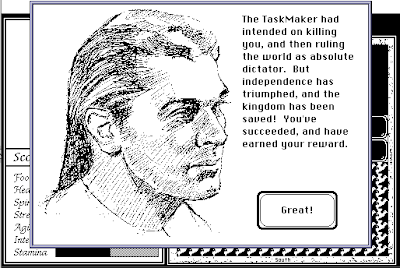 |
| Can my reward be a haircut? |
TaskMaker
United States
Storm Impact (developer); XOR (publisher)
Released 1989 for the Macintosh
Remade and re-released as shareware in 1993
Remade and re-released as shareware in 1993
Date Started: 15 May 2020
Date Ended: 25 May 2020
Total Hours: 13
Difficulty: Moderate-Hard (3.5/5)
Final Rating: (to come later)
Ranking at time of posting: (to come later)
Summary:
TaskMaker is perhaps the perfect Macintosh game. A challenging game with an easy interface, TaskMaker takes the player on a top-down quest to complete 10 tasks for the titular lord, each one progressively more ominous and evil, until at the end the player has a fateful choice. Gameplay is like a combination of early Ultima and a roguelike, with challenging combats made easier through a vast inventory selection. An unusual set of attributes governs success and gets stronger when exercised. Many of the dungeons have complex puzzles involving teleporters, switches, and hidden doors.
***************
The best metaphor I can find for my TaskMaker experience is that I just had an excellent lunch. It was tasty, filling, and didn’t do anything wrong except lack the gravitas of dinner. It won’t unseat Ultima on the GIMLET–no game that lasts only two entries is going to do that, any more than a great lunch place is going to show up on a city’s “best restaurants” list. But for the meal that it offered, it offered it perfectly. I need a way to distinguish such games beyond the raw quantitative score of the GIMLET.
I wonder if a truly epic, dinner-worthy RPG has been created for the Mac. It’s not like the hardware and software wouldn’t support it, and of course it receives ports of such games. But something about the operating system seems to encourage games (or, indeed, perhaps all applications) that are the equivalent of dragging files to the trash can: tidy, cutesy, intuitive, and yet a bit groan-worthy to someone who grew up typing DEL FILE.TXT and still finds it easier to do so. TaskMaker avoids the worst of other Mac games in this regard–its main character is not, for instance, a smiley face–and it admirably backs up almost all mouse commands with keyboard controls, but it still has that sense of being an “app” rather than a program.
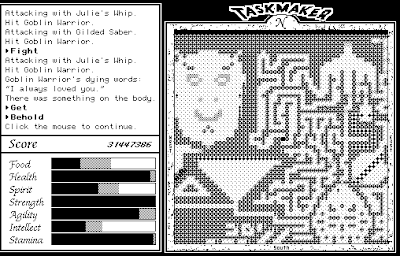 |
| Making cute drawings out of the dungeon wall pattern is something that a Mac game would do. |
Still, the focus belongs on the positives. The titular TaskMaker had ten tasks for me:
- Retrieve a package from Skysail Village.
- Retrieve a chessboard from within the castle.
- Invade the silver mines, kill the usurpers, and bring back a golden chalice.
- Dig in the sands of Porta to find a magic item.
- Remove his belongings from the Quagmire Estates.
- Steal the coat of arms from the Enitsirhc Family, which “resists [his] reforms.”
- Slay and bring the head of the leader of a rebel faction in Dripstone.
- Raid the crypts at Pentamerous and bring back the body of the previous king.
- Bring back the crown of the land from Vidair’s Tower.
- Murder the prisoner in the TaskMaker’s island prison.
The steps needed to accomplish these tasks are designed exactly as they should be in a game of this nature. Too many developers, in such a situation, would mistakenly try to create “symmetry” among the tasks by giving them all a similar structure and length, or even worse make them escalate in complexity. But TaskMaker does it right. Some of the tasks are easy, some are hard. Some are long, some are short. To the extent that any are challenging, the challenge is a bit different for each. The variety keeps things interesting and prevents the player from learning to dread the next task.
 |
| Digging holes in the desert was boring but easy. |
Even better, while the task order is linear, the game world is not. The player could perform all of the tasks before speaking to the TaskMaker once, then stand in front of him and turn them in all in a row. Nothing is gated. If he knows what he’s doing, or just has a bit of daring, he can plunder some of the best equipment early in the game. It would be fun to do a speed run of TaskMaker just to see how quickly you could complete it.
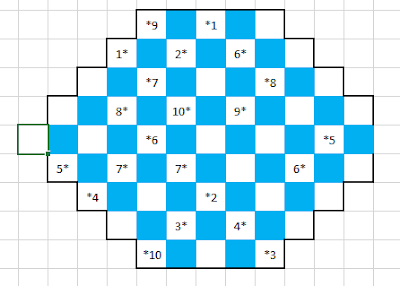 |
| Mapping out a teleport puzzle in one of the last dungeons. |
I particularly love that the player didn’t put up artificial barriers to two slightly game-breaking options: The “Teleport” spell, which moves you to a random place in the current map, and various items that let you walk through walls (e.g., Ethereal Potion, Passwall Scroll). Most games would offer these options but keep you from using them when they really counted. Not this one. I got lucky with a “Teleport” spell on Task 9 and bypassed most of what was probably the game’s toughest dungeon. That in some ways, it’s too bad that you can do this is outweighed by how awesome it is that you can do this.
The easiest tasks were #2–the chessboard was just down the hall, though guarded by some tough early-game foes–and #10. The toughest were the ones that had long, large dungeons: #3, #6, #8, and #9. The game specialized in Dungeon Master-style puzzles like switches, teleporters (visible and invisible), energy barriers, and illusory walls. Vidair’s Tower consisted of about 50 small areas interconnected by such devices. They ultimately frustrated me, even though I could have taken the time to map them, and on a different night may have had a great time doing just that. On the particular night I was playing, my impatience led me to try “Teleport” and I was tickled to see it rewarded.
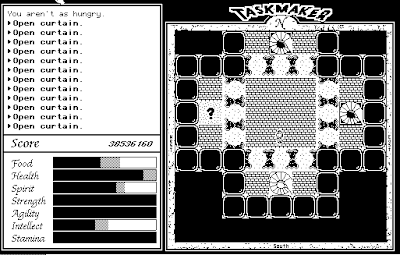 |
| A choice of three staircases and a teleporter. Instead of mapping all these paths, I rolled the dice and got lucky. |
The combat difficulty I reported in the first entry got easier as the game progressed and I got better equipment. I still probably over-relied on the “Instant Vacations” that my deaths unintentionally replicated, but those deaths became rarer as the game went on and, in particular, as I learned how to effectively use the spells. This is another area that the game does quite well. There are ten spells given to you at the outset, and all are useful. Even if you don’t use “Teleport” to bypass dungeon puzzles, you can use it to get out of combat. Even a melee player should use “Attack” frequently because it applies your physical attack to all adjacent foes. “Haste” lets you escape monsters (as well as fight them more efficiently). Even better, NPCs give you additional spells throughout the game, called by casting the “Invoke” spell and then typing their names. HOME is a particularly useful invocation that warps you out of wherever you are and back at the starting location. As I speculated last time, casting spells is what exercises “Intellect” and “Spirit” (and to some extent, “Health”) and causes those maximum bars to increase.
TaskMaker also gives you a lot of inventory resources to take the edge off combats, first in the form of increasingly good stuff to wear and wield, but also in a fun variety of usable items like scrolls, wands, and potions. It is in this area that the game starts to feel a bit like a roguelike, although without the interaction between objects that characterizes that sub-genre.
It probably doesn’t surprise anyone to learn that the TaskMaker is actually evil–he does call himself “The TaskMaker,” after all. From the game’s earliest moments, his over-reactions if you return to him without completing the task show at least a lack of kingly composure, if not outright malevolence.
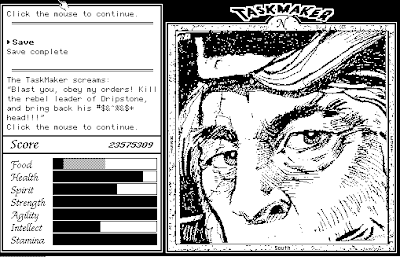 |
| Lord British never gave me this kind of quest. |
You start to get real confirmation of his villainy during your invasion of the castle of the Royal House of Enitsirhc (the developer must have known someone named “Christine”; there’s also a Scroll of Christine in the game). NPCs say things like, “No one must serve the TaskMaker” and “Please help us. Kill the TaskMaker.” In Dripstone, you get the sense that the rebels are more like freedom fighters than terrorists. As a reward for Task 8, the TaskMaker says “may this keep you ever faithful” and then gives you “DRUGS!”
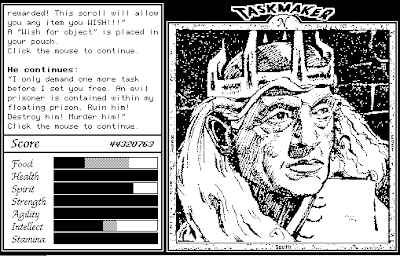 |
| The TaskMaker’s instructions on the final task are also a bit of a clue. |
Unfortunately, you can’t do anything about it until the final task. If you try to turn on the TaskMaker and slay him during any of the previous game, he just laughs at you. You don’t really get any choice until the final task, when you visit the incarcerated prisoner, apparently another rebel leader. “He wants absolute power of the kingdom,” the man says, clearly speaking about the TaskMaker.
If at this point you choose to kill the man, he says “you just killed a good guy” as he dies. From then on, every NPC in every town is hostile to you. When you return to the TaskMaker, he mocks you for following all his orders and then apparently has you killed. The game isn’t 100% clear.
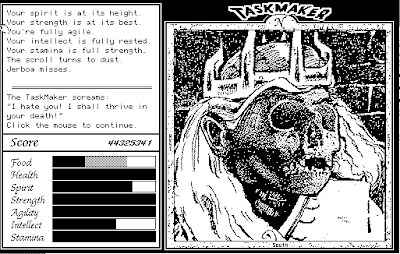 |
| Also, he’s either undead or really good at illusions. |
If instead you leave the prisoner alive, the TaskMaker attacks you upon return, also bringing his guards into combat. I didn’t find the battle very hard. I don’t think I had to even dip into one of my “Instant Vacations” or healing potions.
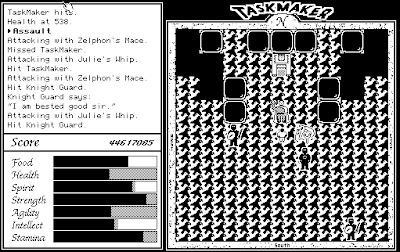 |
| Fighting the TaskMaker in the final battle. |
When he dies, you get the message at the top of this entry, but even better, you get a new special menu called “Master,” which gives you godlike powers over the game world. You can conjure any object, NPC, or monster; change the tiles to any type of floor, furniture, or wall; and toggle time stop, x-ray vision, and ethereal movement. Among other things, this gives you the ability to fully investigate dungeons you may have only partly mapped. It turns out there was a lot to find in the TaskMaker’s very own castle. What a fun reward.
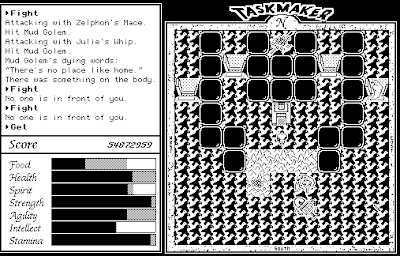 |
| Using my new powers to block my throne room with fire. |
In a GIMLET, the game earns:
- 4 points for the game world. The backstory doesn’t break any new ground, and there isn’t much lore, but I like the way that your actions have permanent consequences (which you can reset!) and the way that the “Info” command gives you a little history of each new location. I just wish the TaskMaker hadn’t been called such in-game and the game had taken his story and yours a little more seriously and thus put a real dagger blade on the twist ending.
- 4 points for character creation and development. The creation process (specifying qualitative attributes) is creative, and I like that your development is based partly on how you act. I like that it’s possible to gravitate towards a warrior or mage “build” based on what skills you favor. I do wish that the game offered more options than just warrior or mage, and that it made better use of its own alignment system.
- 3 points for NPC interaction. Unfortunately, I think NPCs were a lost opportunity for this game. Instead of using them to introduce game lore, the developer just gave them each one or two lines (depending on whether they have anything different to say after you bribe them). None of them are really necessary, and only a tiny percentage are even helpful.
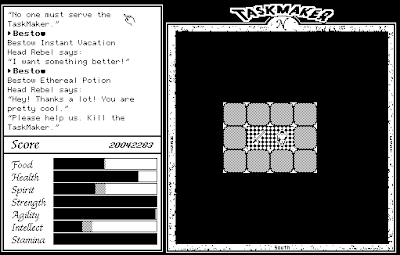 |
| Even when bribed, the rebel leader tells me nothing I don’t already know. |
- 3 points for encounters and foes. Foes are just names and how hard they hit. There are no special attacks or defenses, and a lot of the time, I didn’t even pay attention to the names. The non-combat encounters, in the form of puzzles, were more interesting.
- 5 points for magic and combat. It seems like you just stand in front of enemies and exchange blows, but as I mentioned, the game’s approaches to magic and inventory give you a lot more to do in combat than just keep hitting “fight.” I like the magic system with its “extra” spells, many of which I didn’t discover.
 |
| An NPC gives me a new spell keyword. |
- 7 points for equipment. The game is generous with useful inventory, inventory slots, and backpack space. It lacks the descriptions, crafting, and interactions among items that would be necessary for a higher score.
- 5 points for economy. It’s useful until about halfway through the game, when you amass so much money the store no longer sells anything you need. The ATMs are a fun touch, though one of many things that make it hard to take the world seriously.
- 4 points for a main quest, in manageable stages, with a couple alternate endings and side-areas.
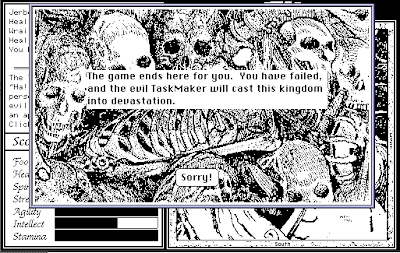 |
| The “evil end” of the game. |
- 3 points for graphics, sound, and interface. It gets most for the interface. I found the graphics a bit too detailed for what the resolution was actually able to deliver, and the sound with its recorded voices contributes to that “cutesy” Mac quality I talked about. The first two times I heard “what is it?” when I went to identify something made me chuckle. Then I turned the sound off.
- 7 points for gameplay. It’s as nonlinear as it can be for a game that presents tasks in a fixed order. It lasts a perfect amount of time for its scope and offers a near-perfect challenge. It’s also extremely replayable–I know I missed a ton of content in my first pass, and this is just the sort of game that would make speedrunning fun.
That gives us a final score of 45, significantly higher than the highest score I’d previously given to a native Mac RPG (Shadow Keep’s 36), high enough to put it in the top 15% of games played so far.
TaskMaker was written by David Cook, whose company, Storm Impact, was based in Illinois. David did most of the coding for the company’s games, while Tom Zehner did most of the large-scale illustrations, including the TaskMaker title screen and TaskMaker portrait. Dan Schwimmer and Dave Friedman helped with playtesting and map design. The team had met in high school and college and were in their first years at college when they founded the company. While TaskMaker sold reasonably well, the company’s most successful game was MacSki (1990).
For years, the original version of the game was lost, but reader LanHawk wrote directly to David Cook and asked him for it, and David obliged. I later corresponded with David by e-mail. He said that TaskMaker began as a Dungeons and Dragons campaign. (This is probably the source of the incorrect statement, found on several web pages, that TaskMaker was originally a board game.) In porting it to the Mac, Tom says he was influenced by Ultima and The Legend of Zelda. But he intended to create a persistent world in which multiple characters could operate even if they couldn’t exactly play together. Future characters would have to contend with the detritus of slain ones. This separation of character state and world state created the unintended item replication bug.
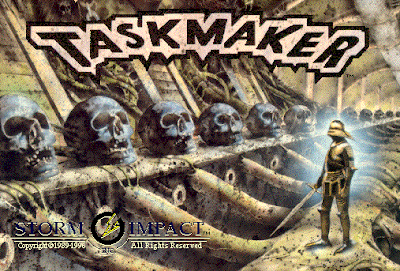 |
| The color in the remake makes it easier to tell what the graphics are supposed to be depicting. |
Version 2 of TaskMaker was released in 1993. This is the one that more players are familiar with. Having experienced a couple hours of it, I don’t believe it’s different enough from version 1 to warrant a new game number and set of entries. The most significant changes that I can see are:
- It’s in full color (but otherwise uses most of the same graphics).
- It comes with a tutorial to get you used to the conventions.
- Some keyboard commands have been changed.
- Some spell names have been changed and the “Teleport” spell is gone.
- There’s no character creation process. Everyone starts with equal values in all attributes.
- The score only increases; it doesn’t decrease over time.
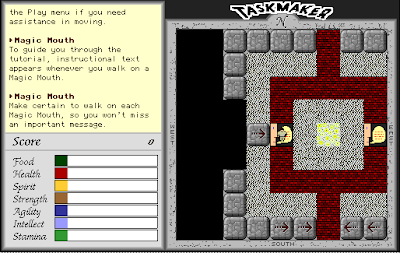 |
| The remake comes with a tutorial with magic mouths. Somehow this makes it feel even more like a Mac game. |
- The save states for the world and character are unified, so the item duplication glitch is gone. You can no longer “reset” a map or the game world.
- There are a few additional sound effects.
- The runic language is gone; wall messages are now in English.
- Combat is quite a bit easier.
- Food depletes at a much slower rate.
- Task #4 no longer has you digging randomly in the desert but rather sends you to a new “Arbalest Catacombs” map.
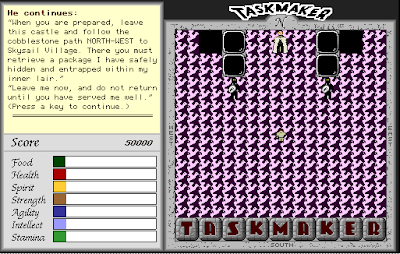 |
| Visiting in the TaskMaker in the remake. |
The increases are mostly an improvement, and I suspect that if I’d played the 1993 version from the outset, the GIMLET would have come in at maybe a 47 or 48.
Storm Impact dissolved in the late 1990s, but David Cook still sells TaskMaker and the company’s other titles on his web page. I can look forward to 1997’s Tomb of the TaskMaker. For now, I think I’ve had enough of a break from The Black Gate to give it another shot.
Original URL: http://crpgaddict.blogspot.com/2020/05/taskmaker-won-with-summary-and-rating.html
